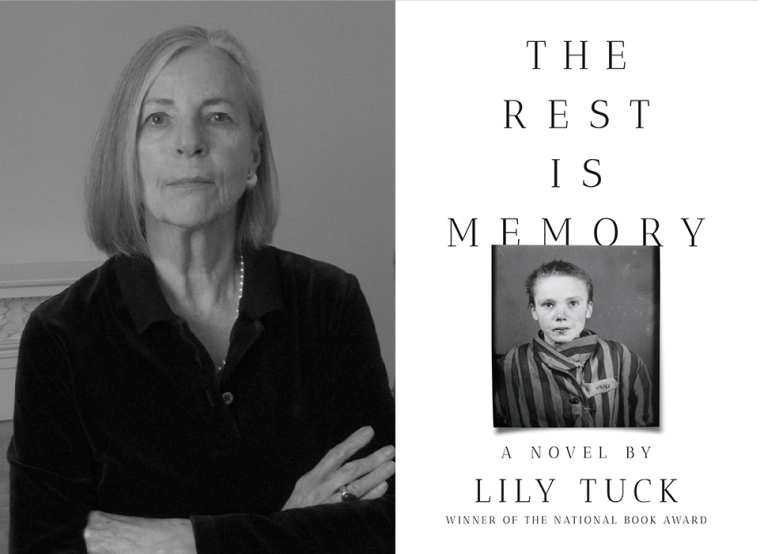This week’s installment of Ten Questions features Lily Tuck, whose novel The Rest Is Memory is out today from Liveright. The novel centers on fourteen-year-old Czeslawa, who is first seen on the back of a boy’s motorcycle in a small Polish village in late 1942. Stripped of her modest belongings, shorn, and tattooed number 26947 on arriving at Auschwitz, Czeslawa is then photographed. Three months later, she is dead. Tuck says that a decade before she wrote The Rest Is Memory, she read an obituary of the photographer Wilhelm Brasse, who took more than 40,000 pictures of the Auschwitz prisoners. Among these photographs were three of Czeslawa Kwoka, a Catholic girl from rural southeastern Poland. Tuck was determined to learn more about Czeslawa, but she was only able to find the barest facts: the village she came from, the transport she was on, that she was accompanied by her mother and her neighbors, her tattoo number, and the date of her death. From this limited information, Tuck began to write The Rest Is Memory. Junot Díaz calls the novel “a literary resurrection, as shattering as it is astonishing,” adding, “Lily Tuck has done the impossible; from darkness and hideous cruelty, she has woven an unforgettable paean to hope, to life, to justice.” Esquire listed The Rest Is Memory as one of its Best Books of Fall 2024 and called the novel, “[h]aunting and austere...tenderly and unflinchingly observed.” Lily Tuck won the 2004 National Book Award for Fiction for The News From Paraguay (HarperCollins). She is the author of seven novels, three short story collections, and a biography of Elsa Morante. The recipient of a Guggenheim fellowship, she lives in New York.

Lily Tuck, author of The Rest Is Memory. (Credit: Julie Thayer)
1. How long did it take you to write The Rest Is Memory?
About a year and a half.
2. What was the most challenging thing about writing the book?
The Holocaust and the vast amount of material associated with the Holocaust that I had to try and make new.
3. Where, when, and how often do you write?
Mornings or afternoons, it varies, depending on whether I am at home or at the library.
4. What are you reading right now?
Intermezzo by Sally Rooney (Farrar, Straus and Giroux, 2024) and Aristophanes’ Old-and-New Comedy by Kenneth J. Reckford (University of North Carolina Press, 1987)—for work. :)
5. Which author, in your opinion, deserves wider recognition?
Jane Bowles, the wife of Paul Bowles, who wrote The Sheltering Sky (John Lehmann, 1949). She was an eccentric and had an innovative, quirky voice. In the 1940s, she lived in a boarding house in Brooklyn known as “February House,” a sort of bohemian commune, whose residents included W. H. Auden, Benjamin Britten, Carson McCullers, Gypsy Rose Lee, a chimpanzee trainer (!), and Truman Capote (Truman Capote wrote the introduction to her collected works). She then moved first to Paris, then Ceylon, and finally to Tangiers, where she lived in the casbah with Paul. She wrote Two Serious Ladies (Knopf, 1943), a novel, In the Summer House (Random House, 1954), a play, and several short stories. Millicent Dillon, another unrecognized writer, wrote a wonderful biography of Jane Bowles called A Little Original Sin: The Life and Work of Jane Bowles (University of California Press, 1998).
6. What is the biggest impediment to your writing life?
I feel fortunate; I can’t think of an impediment, except for maybe age and forgetting everyone’s name….
7. What is one thing that your agent or editor told you during the process of publishing this book that stuck with you?
My agent told me that it was going to be hard to find a publisher for this book and, for only once in his life, he was wrong. He immediately found a publisher.
8. If you could go back in time and talk to the earlier you, before you started The Rest Is Memory, what would you say?
Don’t be afraid.
9. Outside of writing, what other forms of work were essential to the creation of The Rest Is Memory?
A lot of research.
10. What’s the best piece of writing advice you’ve ever heard?
I studied with Gordon Lish and he once said: “Never explain, never complain.”







